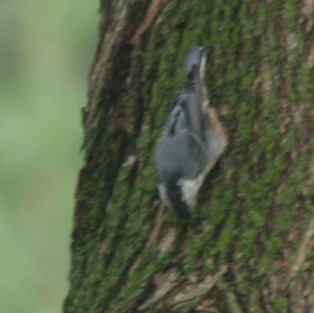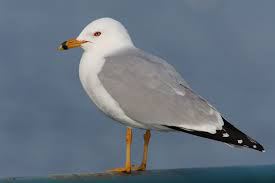Birding Beginnings: Field notes on birds spotted around Eau Claire, Wisconsin
- mnkramer
- Sep 15, 2017
- 4 min read
Recently, I spent a week visiting family in Altoona, Wisconsin, population 7,056, just outside of Eau Claire. This is northern Wisconsin (though not necessarily “Up north” in the local vernacular) and this is indeed the heart of dairyland; since the 1930s, minimum prices for milk have been determined by how far the seller is from Eau Claire (why, you ask? Well, it’s complicated, though short answer is that the rule has, historically, incentivized milk sellers to, quite literally, move product).
I’d been reading Lyanda Lynn Haupt’s The Urban Bestiary: Encountering the Everyday Wild, in which she recommends learning to bird in order to “find the wild thing, the peaceful presence, the animal awareness, in the ordinary moments of the daily lives and places.” So, having more free time than usual while in Wisconsin – enough to make me jittery as a chickadee, I suppose – I set out to bird a bit.
Simply put, birding entails watching birds. So, out windows and on patios and in cars, I watched. Below is a list of birds I saw and was able to identify, mostly within a single acre of bird-watching terrain. I benefitted from feeders offering basic birdseed, suet, and even grape jelly.
You’ll find many species you’d expect to find – blue jay, sparrow, cardinal – but also birds that were, to me at least, delightful surprises – bald eagle, pileated woodpecker, the cedar waxwing. If I was a trained and capable naturalist, I’d be identifying even more species, and identifying them more specifically. For example, in identifying the black-tailed gull, I remain uncertain as to the bird’s exact markings, even though I’m certain the bird was a kind of gull. Intersected by two rivers, Eau Claire is home to a real variety of gulls, and the black-tailed is the area’s most popular, so I’m going to simply trust that the gull I saw (and the many gulls I saw, actually, that hovered above me, seemingly ready to dive bomb any sign of food) was the black-tailed. Truth is, I may have seen three or four other gull species that I could have added to my last, if I was a trained and capable naturalist.
(I should note that these pics are, for the most part, not my own. I’m also not a trained nature photographer, and getting the best nature pics requires hours upon hours of observation, not to mention honed photography skills.)
American Goldfinch
Blue Jay
Ruby-throated Hummingbird
House Sparrow
Black-capped Chickadee
Bald Eagle (young)
Pileated Woodpecker
Baltimore Oriole
Mourning Dove
American Crow
White Breasted Nuthatch
Cardinal
Sandhill Crane
Ring-Billed Gull
Red-winged blackbird
Mallard duck
House finch
Red-tailed Hawk
Cedar Waxwing
Canadian Goose
The takeaway? Of course I learned a few new bird names and behaviors, having coupled my observations with field guide reading. Until this week I thought I’d been seeing “morning doves,” rather than what are really known as “mourning doves” (and until adulthood, I thought I’d been hearing an owl when I heard this; turns out, it’s actually the mourning dove. Possibly you’ve heard this sound as well.) And did you know that sparrows were imported from Europe? They’re so prevalent in the US; I had no idea they’re technically an invasive species.
Bird behaviors turned out to be just as fascinating as their colors and markings and wingspans. The chickadee flitting about, a caffeinated, unceasing refusal to perch for long. The white breasted nuthatch descending trees head first, upside down, in order to feed on bugs crawling within bark exfoliation.
I also came to appreciate my mother (in-law) more as I shared in her birding enthusiasm and gleaned from her own stores of knowledge.
Even more profoundly, I experienced awe. Like many other aspects of nature, these birds strengthen my ability to cope with the world, strengthen my sometimes dwindling belief in a first principle of goodness, a belief that a greater being is, on some level, still holding the world’s reigns. I don’t know how to consider the beauty and intricacies of these creatures’ physiologies and social practices without also considering some source of intentionality.
While lounging alongside rushing whitewater on the Eau Claire River, my wife and I watched a flock of cedar waxwings dance above us. Scattered throughout the surrounding trees, these waxwings intermittently flew out above us and above the river, hovered, darted toward one another, flitted back toward us, presumably scooped up myriad unseen bugs, and then returned to their branches. Their crested heads and black masks reminded me of the cardinal, but their bodies were covered in shimmering grey and umber feathers with sprinklings of vivid vermillion and yellow. They’re called “waxwing” because the ends of their secondary wing feathers have a brilliant, waxy red secretion; no one knows the purpose of this coloring.
Turns out these social birds generally do, quite literally, flock around bug-bearing rivers and, most especially, berry-bearing plant life. Cedar waxwings love their fruit so much that if they come upon over-ripe fruit that’s begun to ferment, they can even become intoxicated. One guide notes that a male-female pair will pass a berry back and forth to one another, beak to beak, for up to 15 minutes until one of them finally eats it whole.
Amazing. And yet it’s easy to take these birds for granted, forgetting that all of this activity and industriousness and beauty hatched out of an egg the size of a shirt button that incubated for just two weeks. Naked, blind and helpless hatchlings weighing one-tenth of an ounce developed their senses, varied organ systems, and feathers and flying abilities until they quickly became those adult-sized, one-ounce creatures feasting upon river bugs and flitting above my wife and me.
The cedar waxwing reminds me to pay attention, to details, to the processes of everyday life, to people, to my own emotions, to art.
~~~

(And then this rare sighting of the native-to-Wisconsin Long-Legged Preeteen, shown here mid-cartwheel. As these strange birds age, they tend to preen and ruffle feathers more and more.)












































Comentarios